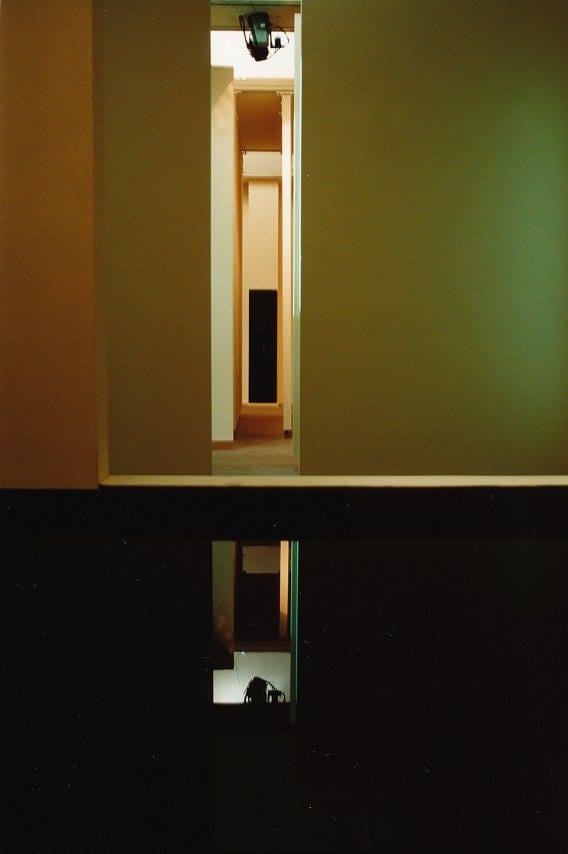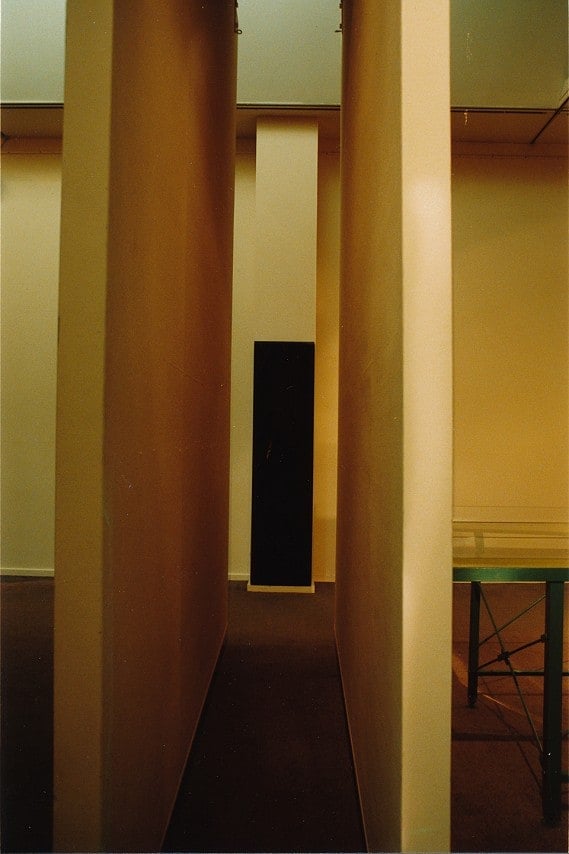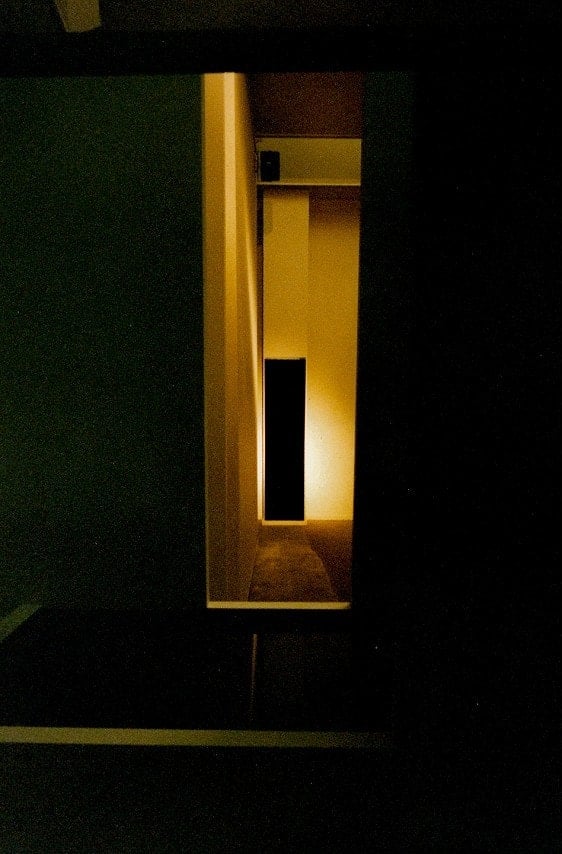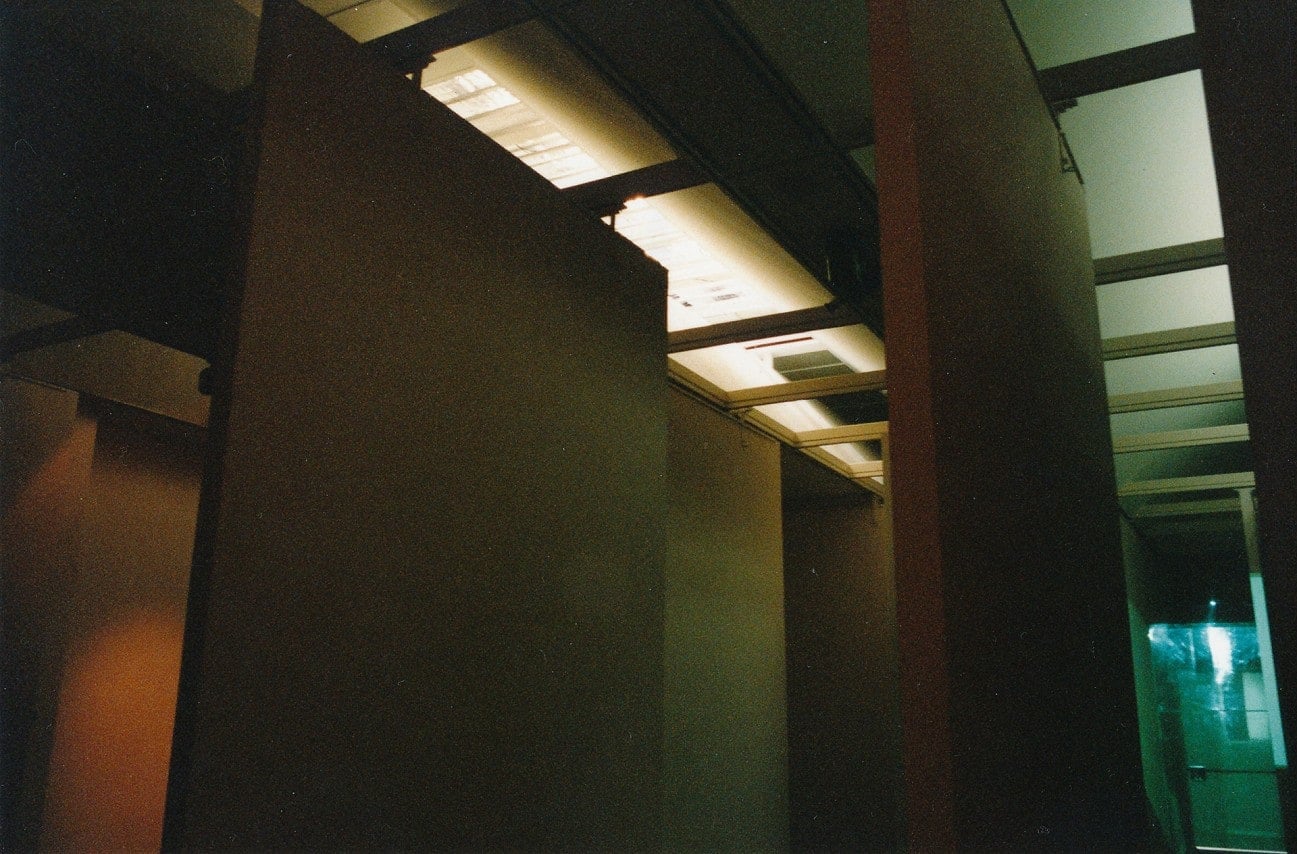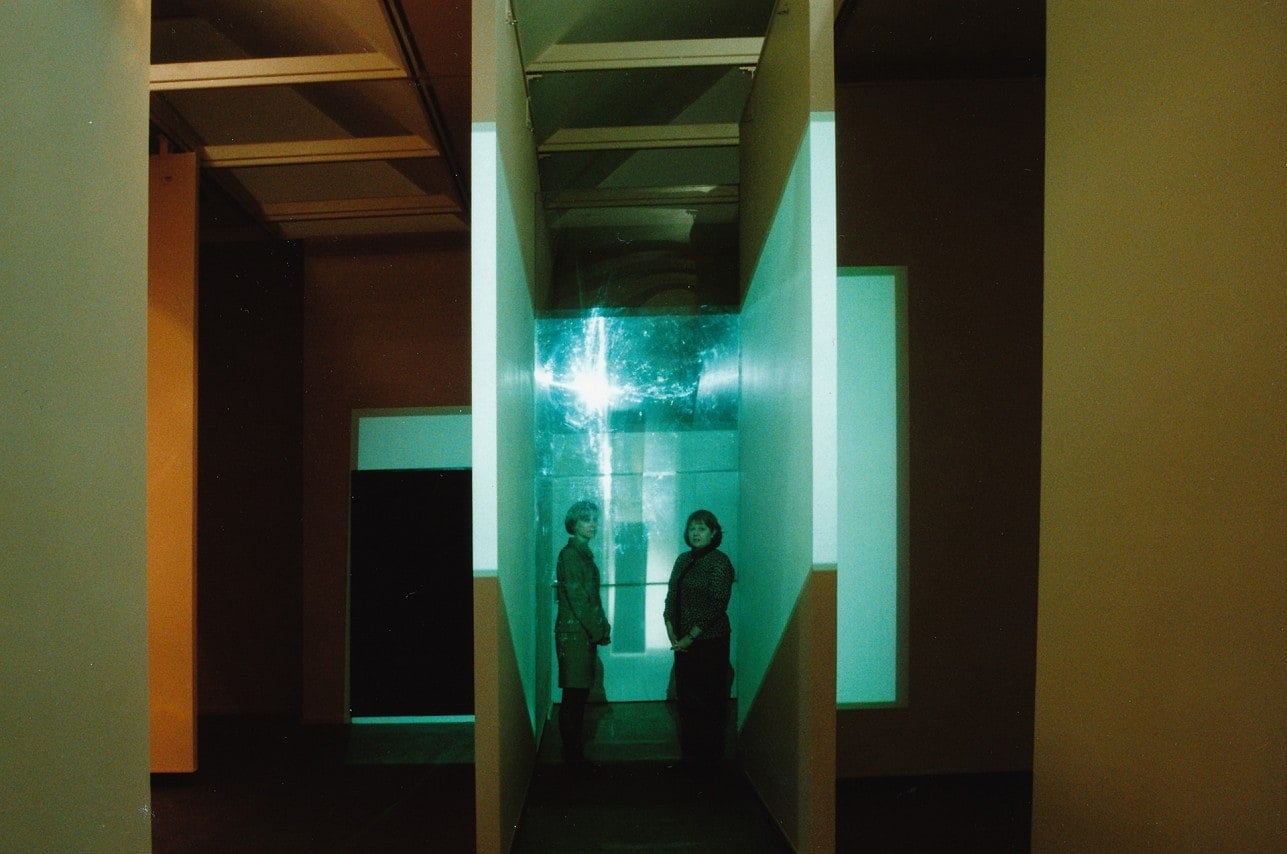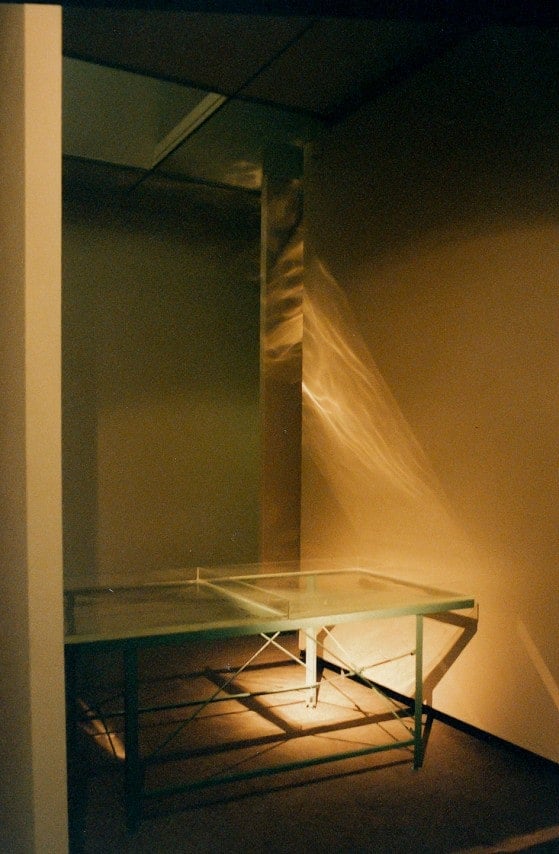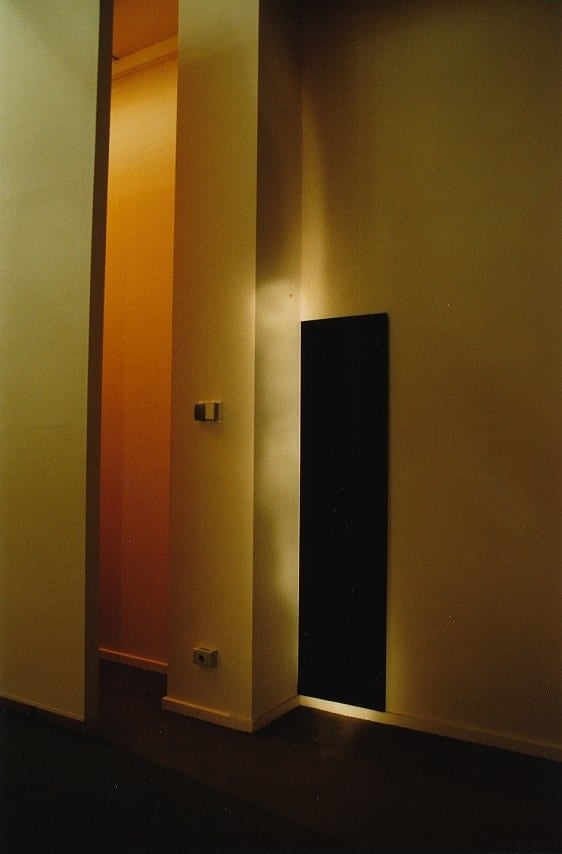Sleeping Between Whispering Walls 2002
09 Sep 2002 : Orange Regional Gallery, Orange, NSW, Australia
Catalogue Essay : Sleeping Between Whispering Walls – The purpose made Gallery,
The physical part of this work is best described as an architectural intervention, where Alan Schacher has used elements that are already existing as part of the architecture of the Gallery in a radical new way. He uses all 33 of the floor to ceiling screens in Gallery One, and has arranged them to form a strange internal architecture that is reminiscent of a labyrinth, as well as war memorial architecture, in a series of discrete interpenetrating spaces. He has then added further elements that are minimal in themselves, yet serve a radical purpose in architectural terms, acting as punctuation marks to the flow of space, and serving as visual “sounding boards” for the spaces, echoing their shape as a black “negative image”.
Schacher deliberately ruptures the “normal” architectonics (flow of space) with blocked corridors, and with tunnel like forms at each end of which is a reflective surface of polished black Perspex or with a high clear screen of transparent Perspex upon which a video projector plays an image of another part of the space. Some people find Sleeping Between Whispering Walls disorienting and confronting, as it is meant to open visitors to the almost infinite possibilities of this space and takes us beyond the spatial “comfort zone” in which we live most of our lives.
The lights are dim, but not too dim to see the hanging black curtains and Perspex accents that literally reflect the way the space has been arranged and inform the dominant feature of the installation..a twenty-foot long trough of sump oil.
This appallingly deep black void is fixed between high cream walls with cream surrounds making a very beautiful yet disturbing reflecting pool that is as untouchable as the infinite void it represents. There is no better reflecting surface than sump oil, and gazing into its evocative depths redolent with paradoxically industrial olfactory reminiscence, is a very strange experience, like a teenager staring into a mirror, there is a temptation to (like Alice) step through into infinite space.
Of course it is the presence of this oil that has caused us to forbid children entry. It is important even for adults they are told not to touch the oil, as it can stain clothing and is difficult to get out.
Reflected in the oil one sees that part of the ceiling has been removed, showing the rafters and fluorescent tubes with their silver foil that had previously given the illusion of daylight.
For Sleeping Between Whispering Walls is not about illusion, it is about revealing what is actually in the space, and adding further actualities to this presence. Another feature, come upon by surprise, is another trough, this time filled with clear water, the very opposite in nearly every way to the viscous impenetrable trough of oil. This is lit by pin spot, revealing just what it is, clear, vapid and pure, transparent, yet more visible in fact than the oil, which is so reflective that one sees not it, but what it is not.
The Soundscape by Rik Rue is presented through eighteen high quality hidden speakers, with four huge hidden amplifiers to generate the purest imaginable sound to three distinct zones. The sound perfectly matches the notions of the space, being derived from simple everyday sounds like fires crackling, water dripping, cars starting, yet isolated in purity and presented as rare holy sounds which sound completely remarkable…mostly because of their new context and the lack of their usual context.
Rue has altered the individual sounds very little. Rather he presents them as Schacher does his minimalist spatial elements, as interpenetrating elements whose interaction is still, metaphorical, and complete. The sounds emerge from darkness calmly, with a leisured procession; there are no startling cheap tricks in this work. Anything that surprises is due to a restrained way of seeing and understanding rather than a Luna Park trompe l’oeil hall of mirrors effect.
The sounds penetrate each other, moving in crisp purity from zone to zone of the installation more like discrete atoms gently striking each other than in swelling waves. This is an installation that reminds one of logical positivism, not romanticism. Yet this is not to say that the installation does not induce fear. The technical precision does not deny spiritual readings of this marvelous installation.
The use of voids, musical and architectonic, in many people, me included, raises that famous “horror vacuii”, that spectre of nothingness that is one of the scariest possible notions. No God, No Thing. The smell of oil and its presence signifying the deep underground, the black pressure of not being, the labyrinth at whose heart lies the beast of emptiness, the sea of forgetfulness.
I think of that quintessential Buddhist notion of the Void…what is the Void, is it a stage on a spiritual journey, like the Dark Night of the Soul of St John of the Cross, or is it the atheist end in itself?
For myself, I have always been comforted by the notion that supposedly empty space is actually filled with a dark matter of such utter impenetrability that nothing is known of its nature, and that all space is crossed with billions of varying wavelengths of sound that our miserable ears cannot yet hear. Furthermore, I believe with the ancient Greek philosopher Parmenides that by definition, there can be no “not-being”. God is too merciful in practice in this life to allow a true void to exist.
This exhibition, in post modernist fashion, is about what is absent, as much as what is included. It is a striking notion to make a space dedicated to the display of art objects, a display in itself without artworks. The sounds too are about absence, space between sound, as much as the sounds themselves. However, this is also a modernist exhibition, in that the main goal is to give the viewer a new way of seeing the familiar, to open up possibilities that can enlarge our experience of life and spirituality.
Alan Sisley
Project Details
| Dates | 09 Sep 2002 to 28 Sep 2002 |
| Duration | 2 weeks |
| Collaborators | Rik Rue : Sound Artist ; Ian Bowie : Technical Installation ; Alan Schacher : concept, design and installation |
| Producer | Orange Regional Gallery, Alan Sisley : Director |
| Category | installations |
| Credits | supported by Arts NSW |


